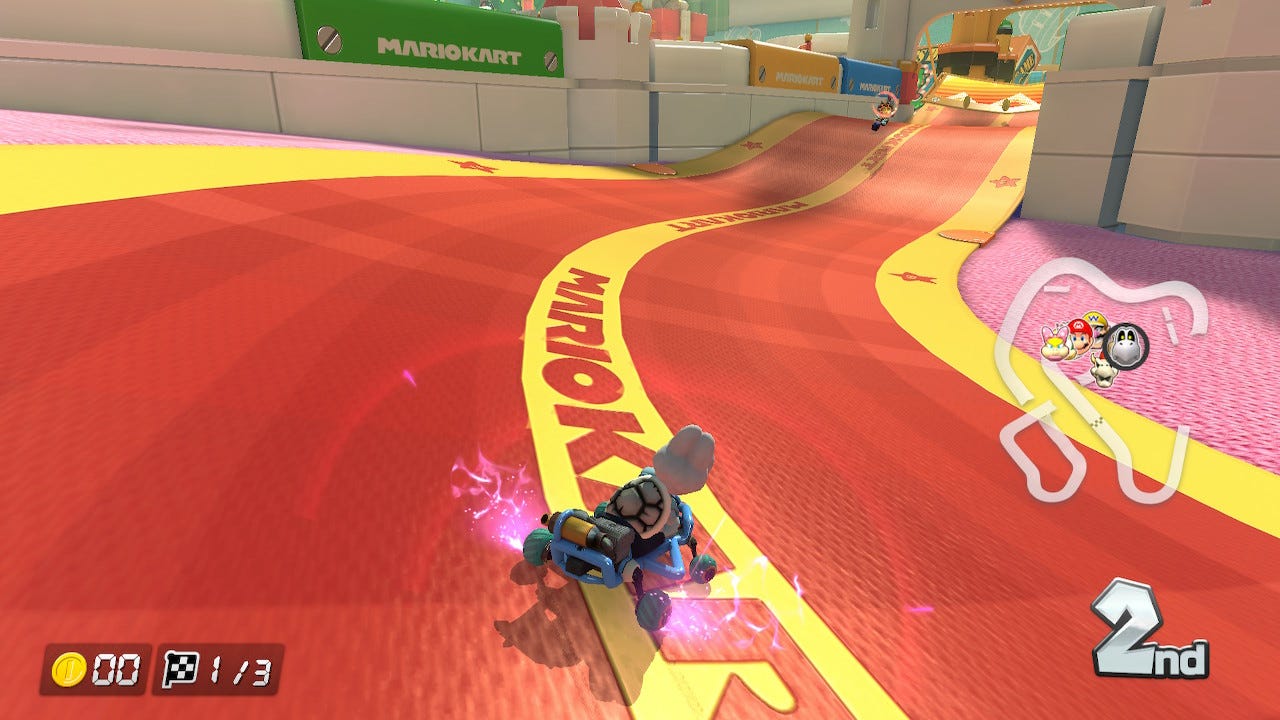Mario Kart 8
Not the abomination that is Mario Kart Wii (Mario Kart Pii, as I call it)
Much of what video games are (is?) is just little gameplay loops repeated over and over again. Role-playing games have their battle systems, first-person shooters have their core shooting mechanics, and free-to-play games have their exploitative economic practices (that last one doesn’t really fit, but it felt good to type). Racing games have their, well, racing, and Mario Kart 8 excels at the core loop of racing.
For the most part, races in Mario Kart 8 are relatively homogeneous. You start the race, try and hit the acceleration button at the exact moment when the two appears on screen, and drift your way to victory. But it’s that last step, drifting, that simultaneously keeps Mario Kart engaging and accessible while other, more realistic racers can only manage that first bit.
Cornering is what makes driving games interesting to play at all. In the absence of turning, races would be decided by who picked the fastest kart at the character select/customization screen. Cornering (at least in the digital space [please pay attention while you’re driving in real life, even on a straight shot like a highway]) is the only real challenge in Mario Kart, besides maybe item management (a more contentious topic deserving of its own stack).
So, cornering makes up the biggest, most complex part of the loop that is driving in Mario Kart 8. What are the other parts of that loop? Well why don’t we just break it down in a list format like this:
Drive straight
Notice a corner
Judge the angle of that corner’s corner
Decide whether that corner’s corner’s angle necessitates a drift (for the sake of illustration, it does)
Begin to drift
Hold the drift steady enough and at such an angle as to put you the furthest along the next straightaway in the shortest amount of time
Let go of the drift
Repeat
Every part of that loop from step two on is part of drifting. Within that sub-loop of drifting there’s a bunch of tiny decisions that need to be made and a lot of room to improve within each of these tiny decisions. For example, step six, the one about actually drifting, provides a tremendous amount of room for a prospective player to improve their lap times. Can I hug that corner a little neater next time? Can I start the drift earlier so I can get a better boost on the back end? And the speed at which Mario Kart 8 moves (especially on higher difficulties) makes sure that drifts never become a cakewalk. The timings required to corner perfectly, though not as strict as games in the simulation racing genre, often come down to just a couple of frames. This difficulty in execution is what makes Mario Kart, at least for me, such a sticky game.
However, this drifting mechanic is also what keeps racing so accessible in Mario Kart 8. The whole idea of drifting in the game is to make your turn radius a lot more manageable in corners. So, by allowing for this sort of course-correction, and because the physics of Mario’s world are so incredibly different than our own, the game allows for players to correct their mistakes a lot easier than more realistic driving games would. If you start turning for a corner too late, the drifting mechanic allows you to compensate rather quickly and lets you avoid a crash; however, a well-executed drift will always be more efficient than a sloppy one.
I really like Mario Kart 8’s gameplay loop. I like that the same thing that keeps the game so accessible is also what gives it its depth and longevity. Moreover, cornering in this game just feels good to do! It’s a crisp action that hasn’t lost its luster after over seven years of play while also being a simple, elegant design solution that’s only brought down by the presence of Blue Shells and Bullet Bills. Again though, that’s a topic for another stack.
See ya on Friday!


